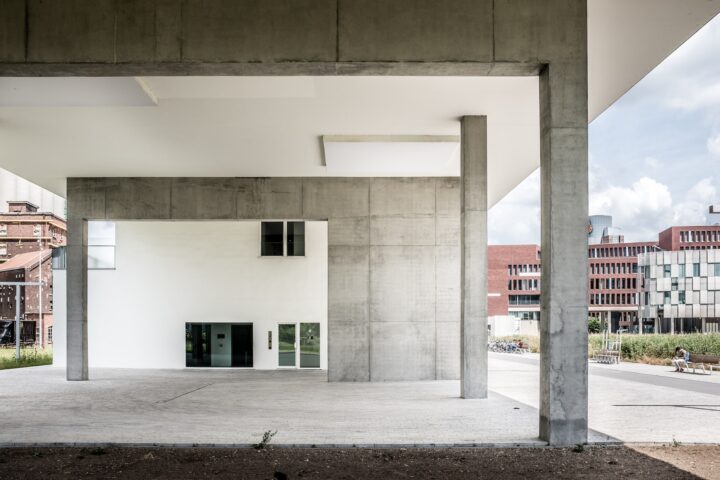Reinforced Concrete: How To Make It And How To Work It
Reinforced concrete is a popular material used in modern construction. It combines the strength of concrete with added reinforcement, such as steel bars or mesh, to increase its durability and load-bearing capabilities.
Thus, it makes sense to know how to make reinforced concrete and work it into your building project. Whether you’re an experienced contractor or just starting on a DIY venture, understanding the ins and outs of reinforced concrete can help ensure that your project runs smoothly from start to finish.

Does Equipment Choice Matter?
The right tools can make all the difference in correctly completing the job. For example, you’ll need trowels and vibrators to help ensure a smooth surface finish, diamond blade saws, and core drills for cutting and forming. You’ll also need special tools for handling the reinforcing steel, such as rebar cutters and benders.
Consider also that some more complex projects may require specialized equipment, such as an overhead crane for lifting heavy loads or a concrete pump for pouring large amounts of material. Also, you may need special tools like thermal blankets and insulated forms to help with the curing process. For stamped concrete, visit https://stampedconcreteboston.com/ for great options as they provide top-quality stamped concrete solutions for residential and commercial properties throughout the Boston area.
There are several types to choose from when it comes to concrete grinding equipment. Hand grinders, electric grinders, and walk-behind grinders all have their advantages depending on the scope of your project. The team at https://diamaprosystems.com/ explains that the quality of everything from diamond core drilling tools to diamond concrete grinding discs can make a world of difference in your project’s outcome. You also need to consider the equipment’s cost to ensure you’re getting good value. The higher-priced equipment may be worth it due to its performance and durability.
What the Making of Reinforced Concrete Entails
Making reinforced concrete involves two components, concrete, and reinforcement. The concrete mixes cement, sand, gravel, and water. This forms the base material that provides stability to structures. The reinforcement is usually steel bars or meshes formed into a lattice pattern that helps to hold the concrete together when it’s under stress from weight or pressure.
The two components are mixed and then poured into the formwork set up to shape it into the desired structure, such as a wall or column. Once the concrete has cured, the reinforcement is embedded inside it, providing extra strength and rigidity while also preventing cracking and spalling.
Finally, the formwork is removed, and the reinforced concrete structure is ready for use. Depending on the size of the project, reinforced concrete can be created on-site or premade at a ready-mix plant and then transported to the job site.
Working with Reinforced Concrete
Once the reinforced concrete has been made, it can be worked into your project. It’s important to understand that this material requires special handling to ensure a successful outcome. For example, proper curing techniques must ensure the concrete sets properly and provides the intended strength and durability. Additionally, the reinforcement must be secured to ensure it’s effectively holding the concrete together. This requires a certain amount of skill and experience to get right.
With these concrete restoration contractors, the knowledge and experience of working with reinforced concrete are invaluable for ensuring a quality finished product. Also, they can troubleshoot any issues that may arise during the construction process, helping to prevent costly mistakes and delays.
When working with reinforced concrete, you also need to consider any additional finishing that may be required. This could include troweling and sealing the surface or applying a protective coating. Also, consider any additional reinforcement necessary for specific situations, such as seismic activity or soil conditions.
Which Are the Common Mistakes to Avoid?
When working with reinforced concrete, it’s essential to be aware of potential mistakes. Some of these include not allowing enough time for curing, not using the correct mix ratios, or forgetting about any additional reinforcement that might be necessary.
Additionally, you need to ensure all tools and equipment are in good condition before beginning a job and check for any potential obstructions that might interfere with the project. Finally, always take proper safety precautions when dealing with concrete, and only attempt to do something beyond your capabilities if seeking professional help.
Considering potential complications, you also need to have a time plan to finish the project. It’s also important to be realistic in this plan, setting expectations for yourself and your crew that can be realistically achieved. Working with an experienced contractor makes the time-planning task seamless. They understand the key elements that halt or slow such projects and will know how to navigate through them.
Reinforced concrete is a robust material used in many different applications. Understanding the intricacies involved in making it and how to handle and work with it correctly is essential. Specialized tools and equipment can also make a difference in the quality of your finished project. You’ll get the most out of this versatile material by learning about reinforced concrete and the various tools and equipment used to work it.


